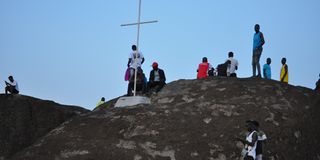Clergy, cultural leaders clash over hill

Some of the youth on top of the hill enjoy their leisure time near the cross that was erected by the Church. PHOTO/PATRICK OKABA
What you need to know:
The erection of a cross by religious leaders has created tension, with allegations of disruption of cultural activities, rituals, and leisure pursuits.
A wrangle has erupted between religious and cultural leaders over Nduru Hill on the outskirts of Nebbi Town.
Tensions flared in April when religious leaders from the Nebbi Catholic Diocese erected a cross atop the hill. This spot was used by Christians for a procession on Good Friday.
However, the erection of the cross has since triggered mixed reactions from the youth, elders, and cultural leaders.
Many express concern that the presence of the cross impedes their ability to carry out rituals and engage in leisure activities.
Religious leaders said the cross was erected to symbolise Jesus’ journey of suffering at Mount Golgotha.
Speaking to the Daily Monitor at the weekend, the Parish Priest of Immaculate Heart of Mary Nebbi Cathedral Parish, Fr Jackson Osiga, said the cross helped to chase away devil worshippers.
“Salvation must come. If people were using the hill for human sacrifices, this would stop because people were created in the image of God, not to be sacrifised to gods,” Fr Osiga said.
Asked if there was evidence to the claims, he could not give conclusive examples.
“We don’t condemn the activities of the cultural leaders on the hill but, many of the cultural people are going beyond the culture by sacrifising human beings contrary to God’s creation,” he said.
The hill is also frequented by pleasure seekers, mostly youth.
When Daily Monitor visited the hill recently, discarded condom wrappers were found scattered, alongside empty waragi bottles.
Mr Godfred Mungujakisa, a youth, said the cross has deterred youth from engaging in inappropriate activities such as sexual encounters and drug abuse.
“We are scared of the holy cross erected by the Church on the hill, because the cross symbolises the holiness of Christ, which everyone must respect. Where the cross was erected conflicts with cultural activities and we the youth may not have respect for that based on different religious and cultural background,” Mr Mungujakisa said.
On Sundays, a number of youth climb the hill, set their music systems and engage in dances until 7pm.
The chairperson of Nduru Hill Resource Development, Mr Kizito Oryema, said they have written to the Church to remove the cross since it was reportedly erected illegally.
“Our aim is to develop the hill as a cultural heritage site for tourism. The cross will bar many people from coming here. We usually get Shs8 million from the telecommunication network that has erected its mast on the hill. So we want the same for tourism,” he said.
Culture on the hill
Mr Alex Manano, the prime minister of the Ocego chiefdom, said the rock served as both an administrative hub and a screening point for Alur, who had been enslaved in the DR Congo by colonial authorities. These individuals were later transported from the Emin Pasha Port in Wadelai, which is now part of Pakwach District.
The mayor of Nebbi Municipality, Mr Geoffry Ngiriker, said the council is planning to transform the place into a tourism site to enhance revenues.
“Community department has identified the place as very potential for tourism sites but due to the wrangles by different chiefdoms claiming ownership, it is hard for Nebbi Municipal Council to develop the site,” Mr Ngiriker said.
However, Ms Barbra Babweteera, the executive director of the Cross-Cultural Foundation of Uganda (CCFU), said one of the biggest threats to African cultural heritage is the Western influence, which overshadows and portrays it as backward and satanic.
“It violates human rights laws to exclude categories of people from enjoying and utilising their heritage just like in the case of Nduru hill. It is the responsibility of the state and the cultural and religious leaders to ensure the protection and promotion of heritage sites,” Ms Babweteera said.
The district conservation officer, Mr Alex Rwothomio, said there is a need to fast-track the process of conserving the heritage.
“We can develop it into rock climbing, hiking challenge, scenic viewing of Nebbi municipality, cave exploration, photography and video shooting, wildlife tracking and visiting the nearby tombs of Agudi and Openja, and that of Nduru in Laji to enhance visitor satisfaction if the site is well planned to enhance revenue collection,” he said.
About the hill
Nduru Hill, commonly referred to as Got Nebbi, is located on the eastern fringes of Nebbi Municipality.
For decades, it has served as a site for adventure, and leisure. This gigantic hill also holds significant cultural value, with the thrones of past traditional chiefs still present at its summit.
Nduru hill is a property of five chiefdoms of Pubidhi, Pagei, Ocego, Paminya and Pawong under the traditional chiefdom of Ocego, as the overseer.
Sets of royal regalia left by Nduru chief, including the royal drum and stool the chief used, can still be found on the hill. The stool is now engulfed by tree roots.
Historically, according to some elders, Nduru hill was a place meant for cultural activities and earmarked as one of the heritage sites in the Alur kingdom where the first harvests of the season, were taken to appease the gods.




